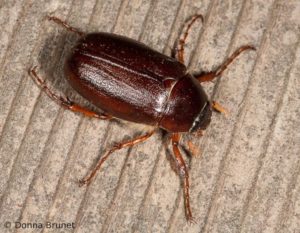Beatles eat plumeria leaves and flowers at night, usually during the month of May/June.
May Beetles
Phyllophaga spp., Scarabaeidae, COLEOPTERA
 DESCRIPTION
DESCRIPTION
Adult — Many species of May beetles (also known as June beetles) occur in any given area. They are shiny, robust insects, reddish-brown to black in color. Oblong in shape, they reach a length of 20 to 25 mm.
Egg — The eggs are pearly white and oblong. Each one, initially about 2.5 mm long and 1.5 mm wide, becomes slightly larger as the larva inside grows.
Larva — Commonly called white grubs, the larvae are white and C-shaped, with a distinct brown head. Young larvae are about 5 mm long, but attain a length of about 25 mm. Two rows of hairs on the underside of the last abdominal segment distinguish true white grubs from similar grubs.
Pupa — The oval, brownish pupae occur within earthen cases.
BIOLOGY
Distribution — More than 200 species of May beetles occur throughout North America. Therefore, a single species population is seldom found. In North Carolina they are most numerous from the Piedmont to the coast.
Host Plants — Although oaks are the favorite food source, adult May beetles also feed on the foliage of many other trees. Larvae prefer lespedeza, sod and corn, but they too have additional host foods which include lawn grasses and nursery plantings.
Damage — Both larvae and adults are destructive. The adults are defoliators, chewing the leaves of various hardwood trees. The grubs feed on and injure the root systems of grasses and other plants. Heavily infested turf can often be rolled up like a carpet, exposing the white grubs.
Life History — May beetles have a 2 or 3 year life cycle, depending upon the species. They overwinter in the soil as larvae in two distinct sizes and as adults that have never flown. In the spring, the adults emerge from the ground in the evening, feed on tree leaves, and mate during the night. They return to some sheltered site in the morning. Females then enter the ground to deposit about 50 eggs in earthen balls. The egg-laying period lasts a couple of weeks. In 3 to 4 weeks, grubs hatch from the eggs and feed on dead organic matter, later moving to the roots of plants. The larvae molt twice, the second and third instars being the overwintering forms. In late August, the second and third instars burrow over 1 meter deep into the ground to hibernate. The larvae do the most damage during the second year. In early spring, third instar larvae construct earthen cells in which they pupate. Adult beetles emerge from pupal cases in late summer, but do not leave the ground; instead, they overwinter there and emerge the next spring.
CONTROL
Sections of turf approximately 929 sq cm (1 sq ft) and 5 to 10 cm (2 to 4 in) deep should be examined for May beetle grubs. On golf fairways, 10 to 12 samples of this size should be taken. If examination reveals an average of three grubs per 929 sq cm (roughly 1 sq ft), treatment is probably necessary.
For specific chemical control recommendations, consult the state agricultural extension service.